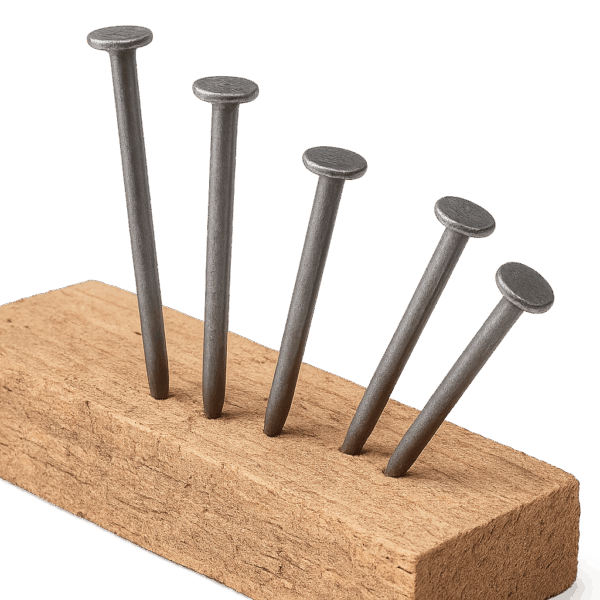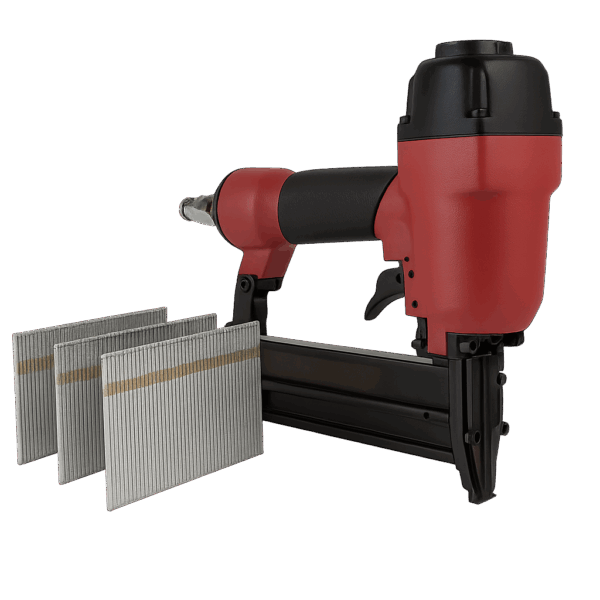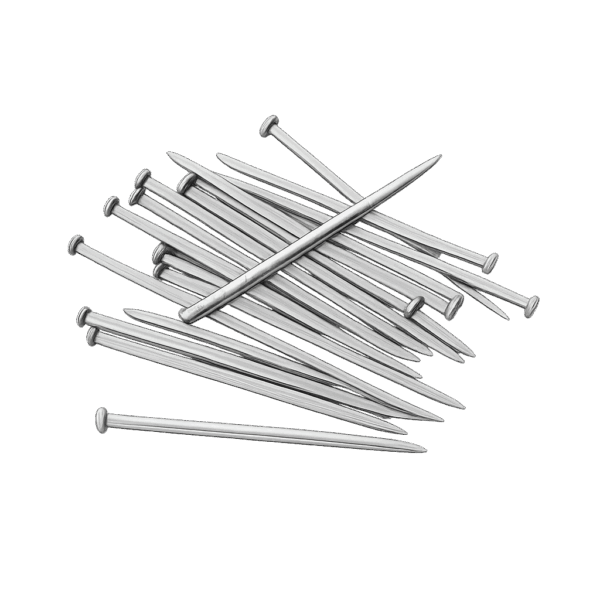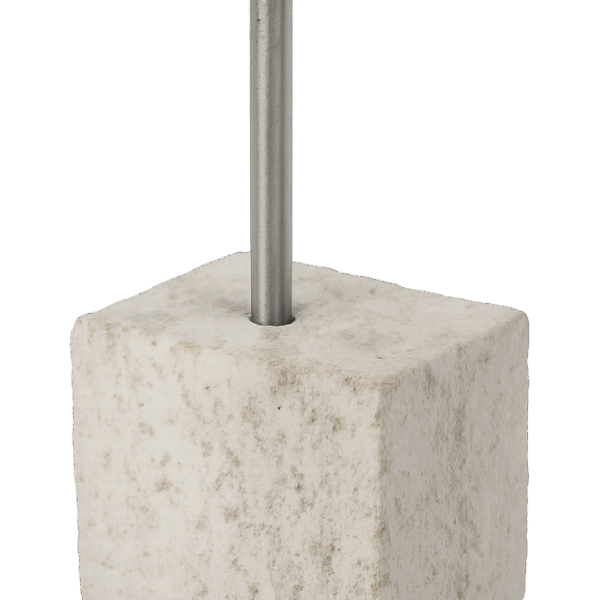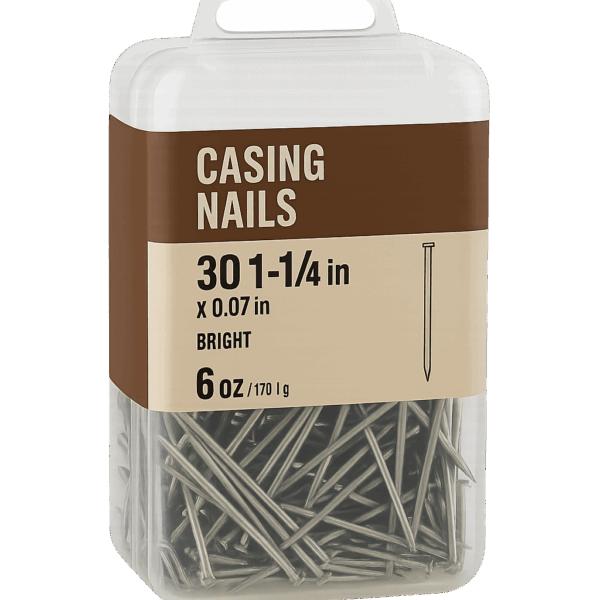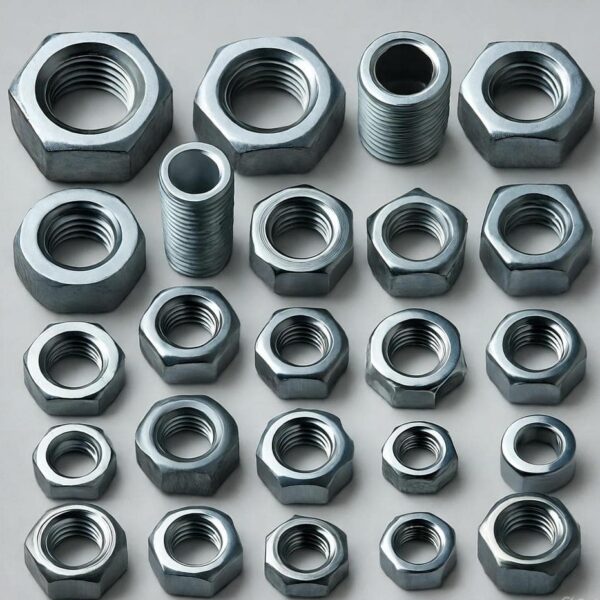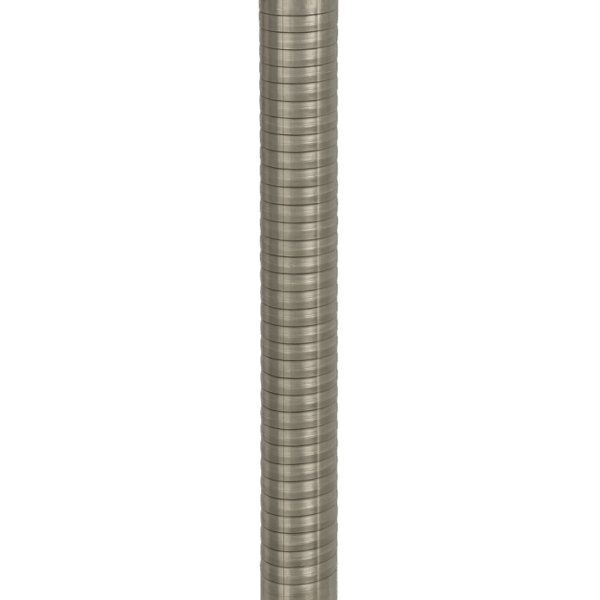N
Box Nail
Nail size is determined by both length and gauge. Nail length is indicated by the letter “d,” which is a system of measurement that dates back to old England and originally represented the word “pennies.” Nails come in many lengths ranging from 2d all the way to 50d with corresponding lengths. While nails may vary between manufacturers, the most common types includes sizes from 2d that is 2 inches to 50d that is 5 ½ inches . Nails must be of suitable strength, with a shank that is long enough to provide an appropriate attachment. Box nails are similar to common nails and sinkers but have thinner shanks. They are better suited to thinner wood materials, such as 1x (3/4-inch-thick) lumber and exterior trim.
Brad Nail
Nail size is determined by both length and gauge. Nail length is indicated by the letter “d,” which is a system of measurement that dates back to old England and originally represented the word “pennies.” Nails come in many lengths ranging from 2d all the way to 50d with corresponding lengths. While nails may vary between manufacturers, the most common types includes sizes from 2d that is 2 inches to 50d that is 5 ½ inches . Nails must be of suitable strength, with a shank that is long enough to provide an appropriate attachment.
Brad nails (or brads) have thin shanks similar to finishing nails. These nails are used in light woodworking. Because of the small shank diameter and the small head, these nails reduce the possibility of splitting the wood. Because they are difficult to drive by hand, brad nails are typically used with a nail gun.
Common Nail
Nail size is determined by both length and gauge. Nail length is indicated by the letter “d,” which is a system of measurement that dates back to old England and originally represented the word “pennies.” Nails come in many lengths ranging from 2d all the way to 50d with corresponding lengths. While nails may vary between manufacturers, the most common types includes sizes from 2d that is 2 inches to 50d that is 5 ½ inches . Nails must be of suitable strength, with a shank that is long enough to provide an appropriate attachment.
Concrete Nail
Nail size is determined by both length and gauge. Nail length is indicated by the letter “d,” which is a system of measurement that dates back to old England and originally represented the word “pennies.” Nails come in many lengths ranging from 2d all the way to 50d with corresponding lengths. While nails may vary between manufacturers, the most common types includes sizes from 2d that is 2 inches to 50d that is 5 ½ inches . Nails must be of suitable strength, with a shank that is long enough to provide an appropriate attachment.
Masonry nails and concrete nails are thick, short, and very strong. They are designed to be fastened into concrete, concrete block, and mortar joints, and are a staple of masonry work.
Duplex Head Nail
Nail size is determined by both length and gauge. Nail length is indicated by the letter “d,” which is a system of measurement that dates back to old England and originally represented the word “pennies.” Nails come in many lengths ranging from 2d all the way to 50d with corresponding lengths. Nails must be of suitable strength, with a shank that is long enough to provide an appropriate attachment.
Duplex head nails have two nail heads, one on top, and another slightly lower. Duplex nails are used for temporary construction, such as formwork for pouring concrete or attaching temporary cleats during roofing. The nail is driven until the lower head is flush with the wood.
Finish (Casing) Nail
Nail size is determined by both length and gauge. Nail length is indicated by the letter “d,” which is a system of measurement that dates back to old England and originally represented the word “pennies.” Nails come in many lengths ranging from 2d all the way to 50d with corresponding lengths. Nails must be of suitable strength, with a shank that is long enough to provide an appropriate attachment.
A finish or casing nail has a small, slightly rounded head slightly bigger than the nail shank. The head is designed to accept the pointed tip of a nail set, making it easier to countersink the nail without slipping.
Naphthalene
Naphthalene is used as an insecticide and pest repellent and as a fumigant , naphthalene vapors build up to levels toxic to both the adult and larval forms of many moths that attack textiles. Other fumigant uses of naphthalene include use in soil as a fumigant pesticide, in attic spaces to repel insects and animals such as opossums, and in museum storage-drawers and cupboards to protect the contents from attack by insect pests. The other largest use of naphthalene is the production of phthalic anhydride, which is an intermediate used to make plasticizers for polyvinyl chloride, and to make alkyd resin polymers used in paints and varnishes
Nitric Acid
Nitric Acid can be produced by ammonia being catalytically oxidized and it is also referred to as aqua fortis and the spirit of niter. There are many nitric acid concentrations available. These are colorless, yellow, or red depending on the concentration. The industrial-grade Nitric Acid is approximately 68% in water, and commercial grade is approximately between 52% and 68%. The fuming nitric acid is around 86% or higher, whereas more than 95% concentrations are red fuming or white fuming Nitric Acid.
that is a common laboratory reagent and an important industrial chemical for the manufacture of fertilizers and explosives. The pure form of nitric acid is colorless, but as it gets older, it turns into a yellow cast. Nitric Acid is is helpful in liquid-fueled rockets as an oxidizer. Ammonium nitrate, used in fertilizers, polymers, and dyes, is created from nitric acid.
Nuts For Bolting
Available Types of Nuts
- Coupling nuts, commonly referred to as extension nuts, are threaded fasteners used to connect two threaded rods.
- Flange nuts, in a flange nut the smooth bearing surface of the flange acts like a built-in washer, distributing the clamp load wider away from the nut.
- Hex nuts, with internal threading are frequently used with machine-threaded bolts and screws.
- Lock nuts have a built-in mechanism inside the nuts to prevent itself from loosening from vibrations.
-
Slotted nuts have grooved heads that fit into holes in the bolt when they are joined, allowing for the cotter pin to be inserted and holding the nut in place.
Ring Shank Nail
Nail size is determined by both length and gauge. Nail length is indicated by the letter “d,” which is a system of measurement that dates back to old England and originally represented the word “pennies.” Nails come in many lengths ranging from 2d all the way to 50d with corresponding lengths. While nails may vary between manufacturers, the most common types includes sizes from 2d that is 2 inches to 50d that is 5 ½ inches . Nails must be of suitable strength, with a shank that is long enough to provide an appropriate attachment. A Ring Shank Nail (annular ring nail ) has rings on its shank for extra grip and additional resistance to pulling out of the wood.
Roofing (Clout) Nail
Nail size is determined by both length and gauge. Nail length is indicated by the letter “d,” which is a system of measurement that dates back to old England and originally represented the word “pennies.” Nails come in many lengths ranging from 2d all the way to 50d with corresponding lengths. While nails may vary between manufacturers, the most common types includes sizes from 2d that is 2 inches to 50d that is 5 ½ inches. Nails must be of suitable strength, with a shank that is long enough to provide an appropriate attachment.
Roofing nails, sometimes called clout nails, have a short shank and a wide, flat, thin head. Roofing nails are used to fasten shingles, roofing felt, or sheet metal to wood. The shanks can be smooth or ringed for increased pull-out resistance.
Shoemaking Nails & Tacks
Nails must be of suitable strength, with a shank that is long enough to provide an appropriate attachment. Shoemaking nails are small, sharp fasteners used in the process of making shoes. They are essential for securing shoe components, especially insoles and heels. Shoemaking nails come in various sizes, typically ranging from 6mm to 26mm, with specific lengths used for different parts of the shoe. Common types include tacks, lasting nails, and buttress heel nails, each with distinct characteristics and applications.

